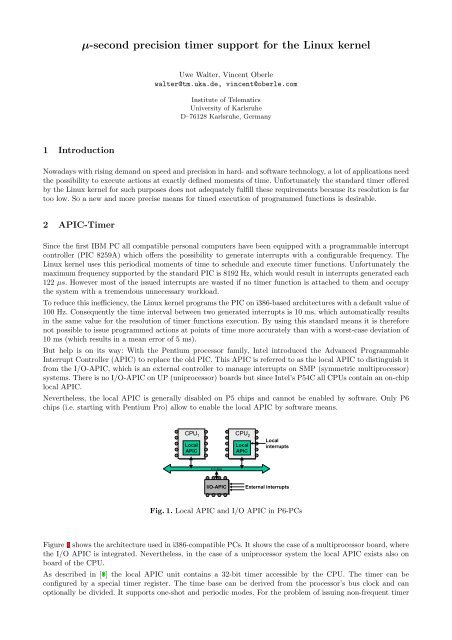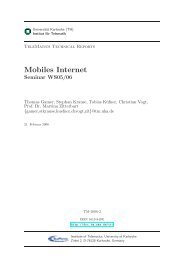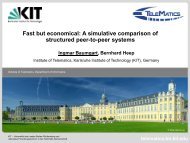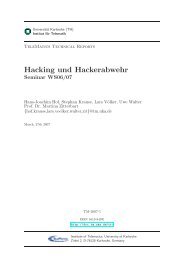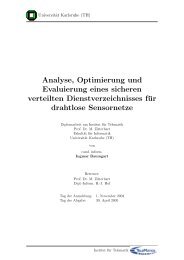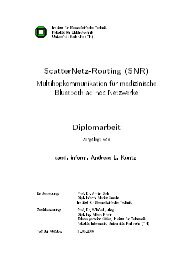µ-second precision timer support for the Linux kernel
µ-second precision timer support for the Linux kernel
µ-second precision timer support for the Linux kernel
Create successful ePaper yourself
Turn your PDF publications into a flip-book with our unique Google optimized e-Paper software.
1 Introduction<br />
<strong>µ</strong>-<strong>second</strong> <strong>precision</strong> <strong>timer</strong> <strong>support</strong> <strong>for</strong> <strong>the</strong> <strong>Linux</strong> <strong>kernel</strong><br />
Uwe Walter, Vincent Oberle<br />
walter@tm.uka.de, vincent@oberle.com<br />
Institute of Telematics<br />
University of Karlsruhe<br />
D–76128 Karlsruhe, Germany<br />
Nowadays with rising demand on speed and <strong>precision</strong> in hard- and software technology, a lot of applications need<br />
<strong>the</strong> possibility to execute actions at exactly defined moments of time. Un<strong>for</strong>tunately <strong>the</strong> standard <strong>timer</strong> offered<br />
by <strong>the</strong> <strong>Linux</strong> <strong>kernel</strong> <strong>for</strong> such purposes does not adequately fulfill <strong>the</strong>se requirements because its resolution is far<br />
too low. So a new and more precise means <strong>for</strong> timed execution of programmed functions is desirable.<br />
2 APIC-Timer<br />
Since <strong>the</strong> first IBM PC all compatible personal computers have been equipped with a programmable interrupt<br />
controller (PIC 8259A) which offers <strong>the</strong> possibility to generate interrupts with a configurable frequency. The<br />
<strong>Linux</strong> <strong>kernel</strong> uses this periodical moments of time to schedule and execute <strong>timer</strong> functions. Un<strong>for</strong>tunately <strong>the</strong><br />
maximum frequency <strong>support</strong>ed by <strong>the</strong> standard PIC is 8192 Hz, which would result in interrupts generated each<br />
122 <strong>µ</strong>s. However most of <strong>the</strong> issued interrupts are wasted if no <strong>timer</strong> function is attached to <strong>the</strong>m and occupy<br />
<strong>the</strong> system with a tremendous unnecessary workload.<br />
To reduce this inefficiency, <strong>the</strong> <strong>Linux</strong> <strong>kernel</strong> programs <strong>the</strong> PIC on i386-based architectures with a default value of<br />
100 Hz. Consequently <strong>the</strong> time interval between two generated interrupts is 10 ms, which automatically results<br />
in <strong>the</strong> same value <strong>for</strong> <strong>the</strong> resolution of <strong>timer</strong> functions execution. By using this standard means it is <strong>the</strong>re<strong>for</strong>e<br />
not possible to issue programmed actions at points of time more accurately than with a worst-case deviation of<br />
10 ms (which results in a mean error of 5 ms).<br />
But help is on its way: With <strong>the</strong> Pentium processor family, Intel introduced <strong>the</strong> Advanced Programmable<br />
Interrupt Controller (APIC) to replace <strong>the</strong> old PIC. This APIC is referred to as <strong>the</strong> local APIC to distinguish it<br />
from <strong>the</strong> I/O-APIC, which is an external controller to manage interrupts on SMP (symmetric multiprocessor)<br />
systems. There is no I/O-APIC on UP (uniprocessor) boards but since Intel’s P54C all CPUs contain an on-chip<br />
local APIC.<br />
Never<strong>the</strong>less, <strong>the</strong> local APIC is generally disabled on P5 chips and cannot be enabled by software. Only P6<br />
chips (i.e. starting with Pentium Pro) allow to enable <strong>the</strong> local APIC by software means.<br />
CPU 1<br />
Local<br />
APIC<br />
ICC-Bus<br />
CPU 2<br />
Local<br />
APIC<br />
Local<br />
interrupts<br />
I/O-APIC External interrupts<br />
Fig. 1. Local APIC and I/O APIC in P6-PCs<br />
Figure 1 shows <strong>the</strong> architecture used in i386-compatible PCs. It shows <strong>the</strong> case of a multiprocessor board, where<br />
<strong>the</strong> I/O APIC is integrated. Never<strong>the</strong>less, in <strong>the</strong> case of a uniprocessor system <strong>the</strong> local APIC exists also on<br />
board of <strong>the</strong> CPU.<br />
As described in [1] <strong>the</strong> local APIC unit contains a 32-bit <strong>timer</strong> accessible by <strong>the</strong> CPU. The <strong>timer</strong> can be<br />
configured by a special <strong>timer</strong> register. The time base can be derived from <strong>the</strong> processor’s bus clock and can<br />
optionally be divided. It <strong>support</strong>s one-shot and periodic modes. For <strong>the</strong> problem of issuing non-frequent <strong>timer</strong>
functions <strong>the</strong> one-shot is interesting, because it does not put unnecessary workload on <strong>the</strong> system. One-shot<br />
mode means, that an initial value is copied into <strong>the</strong> register and counted down to zero with bus speed and an<br />
interrupt is generated when <strong>the</strong> <strong>timer</strong> reaches value zero.<br />
Based on this APIC <strong>timer</strong> a <strong>kernel</strong> module was implemented which exports <strong>the</strong> basic functionality of <strong>the</strong> APIC<br />
<strong>timer</strong> to o<strong>the</strong>r modules. It is realized as a linked list of events, ordered according to <strong>the</strong> expiration time. This<br />
allows to issue <strong>the</strong> <strong>timer</strong>s as fast as possible without a search through <strong>the</strong> complete list. If a <strong>timer</strong> expires, a<br />
user-defined function is invoked, like it would be expected from any normal system <strong>timer</strong>.<br />
The minimum resolution with this APIC-based <strong>timer</strong> is in <strong>the</strong> magnitude of micro<strong>second</strong>s. As <strong>the</strong> bus speed of<br />
modern x86-based PCs is at least 100 MHz, <strong>the</strong> minimum resolution should be 0,1 micro<strong>second</strong>s (1/100 MHz),<br />
but due to <strong>the</strong> calculation time needed <strong>for</strong> switching to <strong>the</strong> interrupt service routine (saving context in<strong>for</strong>mation<br />
etc.) <strong>the</strong> achievable accuracy is about 1 micro<strong>second</strong>. Consequently this is a 1,000 to 10,000 times higher <strong>precision</strong><br />
than <strong>the</strong> default PC <strong>timer</strong>.<br />
3 Implementation<br />
The APIC <strong>timer</strong> consists of two patches and a module <strong>for</strong> <strong>the</strong> standard <strong>Linux</strong> <strong>kernel</strong> tree. The module can be<br />
loaded and unloaded dynamically during runtime and handles all administrative tasks, i.e. adding, modifying<br />
and deleting <strong>timer</strong>s. One objective during <strong>the</strong> development has been to put as much functionality as possible<br />
into <strong>the</strong> module and not into <strong>the</strong> <strong>kernel</strong> itself to keep maintenance and overall view easy.<br />
Un<strong>for</strong>tunately patching <strong>the</strong> <strong>kernel</strong> is still necessary. One patch is needed to activate <strong>the</strong> local APIC on uniprocessor<br />
systems and <strong>the</strong> <strong>second</strong> patch integrates <strong>the</strong> necessary interfaces into <strong>the</strong> <strong>kernel</strong>. Without <strong>the</strong>se modifications<br />
it is not possible to register an interrupt handler <strong>for</strong> <strong>the</strong> APIC <strong>timer</strong> interrupt, because <strong>the</strong> default<br />
handler smp apic <strong>timer</strong> interrupt is hard-wired. This is <strong>the</strong> reason why <strong>the</strong> APIC <strong>timer</strong> cannot be used in SMP<br />
systems, because <strong>the</strong>n its functionality is needed <strong>for</strong> synchronization between <strong>the</strong> different CPUs.<br />
The APIC <strong>timer</strong> module consists of program functions and interfaces <strong>for</strong> <strong>the</strong> users of <strong>the</strong> APIC <strong>timer</strong>. The<br />
difference between <strong>the</strong> usage of <strong>the</strong> standard <strong>kernel</strong> <strong>timer</strong> and <strong>the</strong> APIC <strong>timer</strong> was kept to a minimum.<br />
Registered <strong>timer</strong> handlers are stored in a double linked list, similar to <strong>the</strong> storage of <strong>the</strong> standard <strong>timer</strong> in <strong>the</strong><br />
<strong>Linux</strong> <strong>kernel</strong>. The list elements are structured like this:<br />
struct apic_<strong>timer</strong>_list { struct apic_<strong>timer</strong>_list *next,<br />
*prev; unsigned long long expires; unsigned long data; void<br />
(*function)(unsigned long long, unsigned long) };<br />
– next und prev are used to link <strong>the</strong> apic <strong>timer</strong> list-entries.<br />
– The variable expires holds <strong>the</strong> value of <strong>the</strong> timestamp-counter-register (TSC) at which <strong>the</strong> <strong>timer</strong> function<br />
shall be called and executed. (The TSC is a processor register which is incremented by one at each processor<br />
cycle. It can be compared to a discrete clock with processor speed <strong>precision</strong>.) The necessary conversion into<br />
bus cycle accuracy is done automatically by <strong>the</strong> APIC <strong>timer</strong> module. To improve per<strong>for</strong>mance, <strong>the</strong> linked<br />
list is ordered according to execution (expires) time.<br />
– data is simply a pointer which can point to private data of <strong>the</strong> registered <strong>timer</strong> handler function. This is<br />
extremely useful if multiple instances of a handler function are called and need to keep private data.<br />
– function is <strong>the</strong> pointer to <strong>the</strong> <strong>timer</strong> function which shall be called when <strong>the</strong> <strong>timer</strong> is due. After <strong>the</strong> expires<br />
moment of time has been reached function is called with <strong>the</strong> additional parameter data (see above).<br />
When <strong>the</strong> local APIC issues an interrupt, <strong>the</strong> function do apic irq is called, which, after a few administrative<br />
tasks, itself calls run apic <strong>timer</strong>. That function compares <strong>the</strong> actual moment of time to <strong>the</strong> planned expires-value,<br />
because that difference will be used <strong>for</strong> error correction of <strong>the</strong> following <strong>timer</strong>s to improve accuracy. After that,<br />
<strong>the</strong> expired <strong>timer</strong> is removed from <strong>the</strong> list and its handler function is invoked. When <strong>the</strong>ir job is done, <strong>the</strong> local<br />
APIC will be programmed <strong>for</strong> <strong>the</strong> next due <strong>timer</strong> in <strong>the</strong> list.<br />
The APIC <strong>timer</strong> module exports <strong>the</strong> following functions (which are quite similar to that of <strong>the</strong> standard <strong>timer</strong>,<br />
described <strong>for</strong> example in [2]) as interface <strong>for</strong> its usage:<br />
– init apic <strong>timer</strong>(struct apic <strong>timer</strong> list *<strong>timer</strong>) initializes <strong>the</strong> given structure of type apic <strong>timer</strong> list.<br />
– add apic <strong>timer</strong>(struct apic <strong>timer</strong> list *<strong>timer</strong>) registers <strong>the</strong> given structure of type apic <strong>timer</strong> list and inserts<br />
it into <strong>the</strong> double linked list of registered <strong>timer</strong>s, which await <strong>the</strong>ir execution. The <strong>timer</strong> handler function<br />
<strong>timer</strong>->function will be called when <strong>the</strong> <strong>timer</strong>->expires time is reached.<br />
– del apic <strong>timer</strong>(struct apic <strong>timer</strong> list *<strong>timer</strong>) removes a given apic <strong>timer</strong> list-structure from <strong>the</strong> list of registered<br />
(and waiting) <strong>timer</strong>s.<br />
– mod apic <strong>timer</strong>(struct apic <strong>timer</strong> list *<strong>timer</strong>, unsigned long long expires) modifies <strong>the</strong> expiration time (expires)<br />
of <strong>the</strong> given registered <strong>timer</strong> structure apic <strong>timer</strong> list. Probably its position inside <strong>the</strong> registered <strong>timer</strong> list<br />
has to be updated.
4 Using <strong>the</strong> APIC-<strong>timer</strong> <strong>for</strong> high <strong>precision</strong> traffic shaping<br />
High <strong>precision</strong> <strong>timer</strong>s can be used <strong>for</strong> –and are even needed by– a lot of applications. As an example <strong>the</strong>ir<br />
benefits are demonstrated by using <strong>the</strong>m <strong>for</strong> network traffic shaping. Traffic shapers are an important building<br />
block <strong>for</strong> <strong>the</strong> <strong>support</strong> of quality of service (QoS) in packet networks, because <strong>the</strong>y reduce packet bursts by<br />
delaying packets which arrive too fast <strong>for</strong> <strong>the</strong>ir configured bandwidth. It is obvious that traffic shapers need to<br />
be able to transmit waiting data packets at precisely calculated points of time to per<strong>for</strong>m in a satisfying way.<br />
The accuracy of <strong>the</strong>se timed actions is crucial to <strong>the</strong> per<strong>for</strong>mance of traffic shapers.<br />
To show <strong>the</strong> impact of <strong>timer</strong> <strong>precision</strong> on <strong>the</strong> shaping smoothing level, research was done using <strong>the</strong> following<br />
three <strong>timer</strong>s on a standard 700 MHz PC with a 100 Mbps E<strong>the</strong>rnet connection.<br />
1. The standard PC-<strong>timer</strong>. Its trigger frequency is left unchanged at <strong>the</strong> default of 100 Hz which limits its<br />
accuracy to 10 ms.<br />
2. A modified PC-<strong>timer</strong>. By issuing interrupts with 5000 Hz <strong>the</strong> resolution is improved to 0,2 ms but <strong>the</strong> system<br />
workload increases dramatically because of <strong>the</strong> amount of unnecessary interrupts.<br />
3. The newly developed APIC-<strong>timer</strong>.<br />
APIC-<strong>timer</strong> (∅ 1,9 <strong>µ</strong>s)<br />
Modified PC-<strong>timer</strong> (∅ 84 <strong>µ</strong>s)<br />
Standard-PC-<strong>timer</strong> (∅ 4750 <strong>µ</strong>s)<br />
Fig. 2. Mean deviation of <strong>the</strong> actual to <strong>the</strong> planned transmission time of data packets <strong>for</strong> <strong>the</strong> different <strong>timer</strong>s.<br />
Figure 2 shows <strong>the</strong> mean deviation of <strong>the</strong> planned time a packet should be transmitted to <strong>the</strong> actual value when<br />
it is sent. Figure 3 presents histograms of <strong>the</strong> trigger error <strong>for</strong> differently delayed packets. It is obvious how <strong>the</strong><br />
<strong>timer</strong> resolution affects <strong>the</strong> deviation.<br />
Percentage of packets (%)<br />
6<br />
4<br />
2<br />
0<br />
Standard-PC-<strong>timer</strong><br />
16<br />
12<br />
8<br />
4<br />
Modified PC-<strong>timer</strong><br />
(with increased system load)<br />
0<br />
0<br />
0 2 4 6 8 10 0 50 100 150 200 250 0 1 2 3<br />
Milli<strong>second</strong>s (ms) Micro<strong>second</strong>s (<strong>µ</strong>s) Micro<strong>second</strong>s (<strong>µ</strong>s)<br />
30<br />
20<br />
10<br />
APIC-<strong>timer</strong><br />
Fig. 3. Deviation of <strong>the</strong> actual transmission time to <strong>the</strong> planned sending time <strong>for</strong> <strong>the</strong> different <strong>timer</strong>s.<br />
This <strong>timer</strong> error impacts <strong>the</strong> smoothness of <strong>the</strong> shaped network traffic as it is shown in figure 4. In this experiment<br />
a constant-rate packet stream of 1292 byte UDP-packets should be shaped to a bandwidth of 1 Mbps. This<br />
would result in one data packet transmitted every 10,3 milli<strong>second</strong>s. The figure shows <strong>the</strong> actual interpacket<br />
spacing after <strong>the</strong> shaping process.<br />
When <strong>the</strong> standard PC-<strong>timer</strong> is used, <strong>the</strong> shaper has only <strong>the</strong> possibility to send a packet ei<strong>the</strong>r in 10 or 20 ms.<br />
There is no way to transmit a packet in between <strong>the</strong>se <strong>timer</strong> intervals. The shaper was designed to send packets<br />
early, so it transmits most of <strong>the</strong> packets with a spacing of 10 ms. The configured rate is honored by delaying a<br />
few packets <strong>for</strong> two whole <strong>timer</strong> intervals (20 ms).<br />
The modified PC-<strong>timer</strong> can handle this job a lot better because of its finer granularity of 0,2 ms. It, too, oscillates<br />
between two adjacent <strong>timer</strong> intervals (which is hardly visible in <strong>the</strong> figure).<br />
By using <strong>the</strong> APIC-<strong>timer</strong> it becomes possible to produce a very smooth output data stream. Its very small error<br />
of approximately 2 <strong>µ</strong>s is invisible in <strong>the</strong> figure.<br />
Even at this relatively low bandwidth <strong>the</strong> standard <strong>timer</strong> can only produce a jittering output stream. The two<br />
o<strong>the</strong>r <strong>timer</strong>s per<strong>for</strong>m better and are <strong>the</strong>re<strong>for</strong>e out through a more challenging test. Figure 5 shows <strong>the</strong> results<br />
of <strong>the</strong> test shaping a 667 byte packet stream to a bandwidth of 50 Mbps, which equals sending a packet every<br />
107 micro<strong>second</strong>s.
Interpacket time (ms)<br />
20<br />
15<br />
10<br />
5<br />
Standard-PC-<strong>timer</strong><br />
Error<br />
Modified PC-<strong>timer</strong><br />
(with increased system load)<br />
Scheduled value<br />
APIC-<strong>timer</strong><br />
0<br />
0 20 40 60 0 10 20 31 40 50 60 0 10 20 30 40 50 60<br />
Packet sequence number<br />
Fig. 4. Interpacket times of a shaped 1 Mbps data stream consisting of 1292 byte packets (nominal spacing<br />
10,3 ms).<br />
Interpacket time (<strong>µ</strong>s)<br />
250<br />
200<br />
150<br />
100<br />
50<br />
Modified PC-<strong>timer</strong><br />
(with increased system load)<br />
APIC-<strong>timer</strong><br />
0<br />
0 10 20 30 40 50 60 0 10 20 30 40 50 60<br />
Packet sequence number<br />
Scheduled value<br />
Fig. 5. Interpacket times of a shaped 50 Mbps data stream consisting of 667 byte packets (nominal spacing<br />
107 <strong>µ</strong>s).<br />
In this experiment even <strong>the</strong> modified PC-<strong>timer</strong> is operating over its maximum resolution. The scheduled packet<br />
spacing cannot be maintained and <strong>the</strong> shaper has to send packets ei<strong>the</strong>r immediately or delayed by a whole<br />
0,2 ms <strong>timer</strong> interval.<br />
Again <strong>the</strong> APIC-<strong>timer</strong> shows no signs of decreasing accuracy and produces a smooth packet stream. In following<br />
stress tests <strong>the</strong> APIC-<strong>timer</strong> was even capable of transmitting packets with a spacing of only 17<strong>µ</strong>s be<strong>for</strong>e <strong>the</strong> test<br />
setup reached o<strong>the</strong>r limits (packet generation and transmission). This equals a packet frequency of 58,800 packets<br />
per <strong>second</strong> which would –even with small 100 byte packets– result in a bandwidth of more than 47 Mbps.<br />
5 Conclusion<br />
A new and easy-to-use <strong>timer</strong> module <strong>for</strong> <strong>the</strong> <strong>Linux</strong> <strong>kernel</strong> has been implemented, which offers <strong>the</strong> possibility<br />
to execute functions at precisely defined moments of time. By making use of <strong>the</strong> local APIC’s functionality<br />
an accuracy of about 1 micro<strong>second</strong> is achieved <strong>for</strong> <strong>the</strong> execution time of programmed actions (although only<br />
possible on uniprocessor systems at <strong>the</strong> moment).<br />
The possible benefits of such an improved <strong>timer</strong> <strong>precision</strong> have been shown <strong>for</strong> traffic shaping as a possible<br />
example application.<br />
References<br />
1. Intel architecture software developer’s manual, volume 1-3, 2001.<br />
http://developer.intel.com/design/pentiumii/manuals/24319{0-2}.htm.<br />
2. Alessandro Rubini and Jonathan Corbet. <strong>Linux</strong> Device Drivers. O’Reilly-Verlag, 2 edition, July 2001. Online version<br />
at http://www.oreilly.com/catalog/linuxdrive2/chapter/book.


